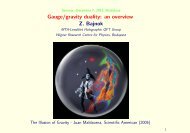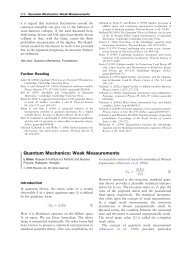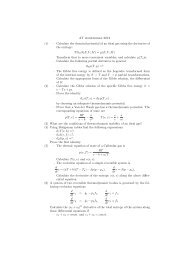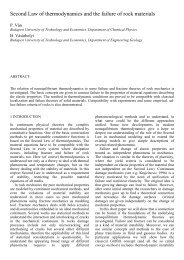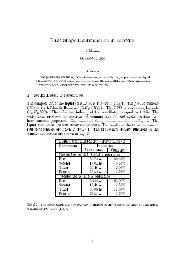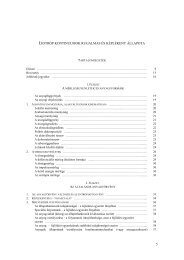hungarian scientists in the us - Columbia University
hungarian scientists in the us - Columbia University
hungarian scientists in the us - Columbia University
Create successful ePaper yourself
Turn your PDF publications into a flip-book with our unique Google optimized e-Paper software.
Zoltán Haiman<br />
Zoltán Haiman is a <strong>the</strong>oretical astrophysicist<br />
and cosmologist at <strong>Columbia</strong><br />
<strong>University</strong>. He graduated from<br />
Fazekas Mihály Gimnázium <strong>in</strong> Budapest<br />
<strong>in</strong> 1989. He received Bachelor of<br />
Science degrees from <strong>the</strong> Massach<strong>us</strong>etts<br />
Institute of Technology (MIT)<br />
<strong>in</strong> 1993 <strong>in</strong> Physics and <strong>in</strong> Electrical<br />
Eng<strong>in</strong>eer<strong>in</strong>g. While at MIT, he was<br />
plann<strong>in</strong>g to become an architect, but<br />
he became fasc<strong>in</strong>ated by <strong>the</strong> many<br />
open questions <strong>in</strong> astrophysics and<br />
cosmology. He spent a year at Cambridge<br />
<strong>University</strong> <strong>in</strong> <strong>the</strong> U.K. as an<br />
Isaac Newton fellow at <strong>the</strong> Institute of<br />
Astronomy, and went on to receive his<br />
PhD <strong>in</strong> Astronomy from Harvard <strong>University</strong><br />
<strong>in</strong> 1998. In his PhD <strong>the</strong>sis, he<br />
pioneered <strong>the</strong> basic <strong>the</strong>oretical understand<strong>in</strong>g<br />
of how <strong>the</strong> first generation<br />
stars formed <strong>in</strong> <strong>the</strong> universe, a subject<br />
that has s<strong>in</strong>ce developed <strong>in</strong>to one of<br />
<strong>the</strong> ma<strong>in</strong> research areas <strong>in</strong> cosmology.<br />
He was a postdoctoral researcher <strong>in</strong><br />
<strong>the</strong> <strong>the</strong>oretical astrophysics group at<br />
<strong>the</strong> Fermi National Accelerator Laboratory<br />
(“Fermilab”) near Chicago, and<br />
later at Pr<strong>in</strong>ceton <strong>University</strong>, hold<strong>in</strong>g<br />
a coveted Hubble Fellowship. He<br />
jo<strong>in</strong>ed <strong>the</strong> faculty <strong>in</strong> <strong>the</strong> Astronomy<br />
Department at <strong>Columbia</strong> <strong>University</strong><br />
<strong>in</strong> 2003, where he is now an Associate<br />
Professor, hav<strong>in</strong>g received tenure <strong>in</strong><br />
2008. He has cont<strong>in</strong>ued work<strong>in</strong>g on a<br />
broad range of <strong>the</strong>oretical problems <strong>in</strong><br />
astrophysics and cosmology, <strong>in</strong>clud<strong>in</strong>g<br />
<strong>the</strong> assembly of <strong>the</strong> first galaxies<br />
and <strong>the</strong> end of <strong>the</strong> cosmic dark age;<br />
<strong>the</strong> nature of dark matter, dark energy,<br />
and <strong>the</strong> acceleration of <strong>the</strong> universe;<br />
and, most recently, understand<strong>in</strong>g <strong>the</strong><br />
process of mergers between supermassive<br />
black holes. He was named as<br />
one of <strong>the</strong> top 10 young <strong>scientists</strong> <strong>in</strong><br />
<strong>the</strong> U.S. by Popular Science magaz<strong>in</strong>e<br />
<strong>in</strong> 2002, and was a f<strong>in</strong>alist for <strong>the</strong> New<br />
York City Mayor’s Award for Excellence<br />
<strong>in</strong> 2004. He was a w<strong>in</strong>ner of <strong>the</strong><br />
2010 Blavatnik Award for Young Scientists<br />
from <strong>the</strong> New York Academy<br />
of Sciences for highly <strong>in</strong>novative, impactful,<br />
and <strong>in</strong>terdiscipl<strong>in</strong>ary accomplishments<br />
<strong>in</strong> <strong>the</strong> life sciences, physical<br />
sciences, ma<strong>the</strong>matics, and eng<strong>in</strong>eer<strong>in</strong>g.<br />
As a professor at <strong>Columbia</strong>,<br />
he has supervised <strong>the</strong> doctoral <strong>the</strong>sis<br />
of eight PhD students, who went on to<br />
prestigio<strong>us</strong> postdoctoral fellowships<br />
at Harvard, Pr<strong>in</strong>ceton, Berkeley, ETH<br />
Zürich, <strong>the</strong> Max Planck Institute for<br />
Astrophysics <strong>in</strong> Münich, <strong>the</strong> <strong>University</strong><br />
Santa Barbara, and <strong>the</strong> <strong>University</strong><br />
of Michigan. He is a frequent visitor to<br />
Eötvös <strong>University</strong> <strong>in</strong> Budapest, where<br />
he has enjoyed work<strong>in</strong>g with several<br />
students. Toge<strong>the</strong>r with his students<br />
and collaborators, he has co-authored<br />
more than 125 peer-reviewed scientific<br />
papers. Besides his regular faculty<br />
appo<strong>in</strong>tment at <strong>Columbia</strong>, he is<br />
currently <strong>the</strong> co-director, with str<strong>in</strong>g<br />
<strong>the</strong>orist Brian Greene, of <strong>the</strong> Institute<br />
for Str<strong>in</strong>gs, Cosmology, and Particle<br />
Physics (ISCAP) at <strong>Columbia</strong> <strong>University</strong>,<br />
and also of <strong>the</strong> new Eötvös<br />
International Research School <strong>in</strong> Astrophysics<br />
<strong>in</strong> Budapest.<br />
The Life and Times of Black Holes Throughout<br />
Cosmic Time<br />
Black holes are a fasc<strong>in</strong>at<strong>in</strong>g prediction<br />
of E<strong>in</strong>ste<strong>in</strong>’s general relativity<br />
<strong>the</strong>ory. Over <strong>the</strong> last 10 years or so,<br />
astronomers have accumulated conv<strong>in</strong>c<strong>in</strong>g<br />
evidence that black holes<br />
not only actually exist, but are ubiquito<strong>us</strong><br />
<strong>in</strong> nature. They are found to<br />
reside at <strong>the</strong> center of every galaxy,<br />
close enough to study <strong>in</strong> detail. Extremely<br />
large black holes, several<br />
billion times heavier than our own<br />
Sun, are also known to have formed<br />
already with<strong>in</strong> a mere 700 million<br />
years after <strong>the</strong> Big Bang. The rapid<br />
assembly of such large black holes is<br />
3632132 31 32<br />
currently an unsolved puzzle <strong>in</strong> astrophysics.<br />
I will describe one possible<br />
solution. which posits that <strong>the</strong> first<br />
stars <strong>in</strong> <strong>the</strong> universe were very massive,<br />
and left beh<strong>in</strong>d “stellar-mass”<br />
seed black holes at <strong>the</strong> end of <strong>the</strong>ir<br />
lives. These small black holes can later<br />
ga<strong>in</strong> weight by <strong>the</strong> gas that spirals<br />
<strong>in</strong>to <strong>the</strong>m, and can build up bigger<br />
black holes by merg<strong>in</strong>g frequently.<br />
Dur<strong>in</strong>g such mergers, <strong>the</strong> black hole<br />
pair emits copio<strong>us</strong> amounts of gravitational<br />
waves, which can be detected<br />
by future space-based detectors, to<br />
test this <strong>the</strong>ory.



